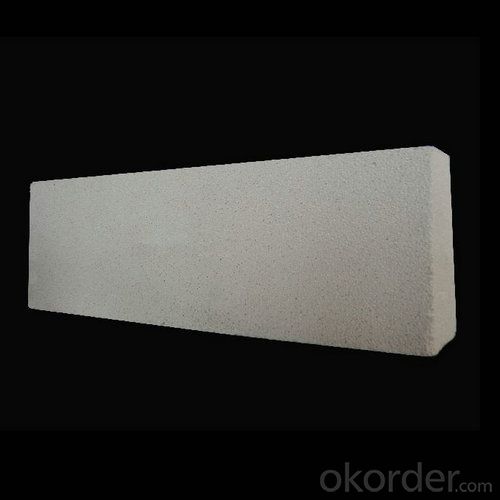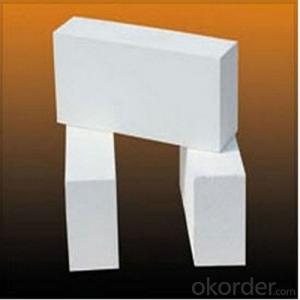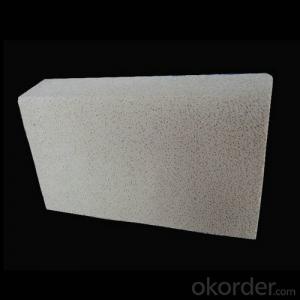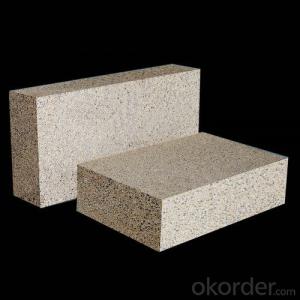Insulation Brick with High Thermal Shock Resistance
- Loading Port:
- Tianjin
- Payment Terms:
- TT OR LC
- Min Order Qty:
- 1 m.t.
- Supply Capability:
- 20000 m.t./month
OKorder Service Pledge
OKorder Financial Service
You Might Also Like
Description of Insulation Brick
CMAX Insulation Brick are classified under temperature between 1300℃ to 1700℃, manufactured from high purity alumina clay.
Features of Insulation Brick
Light weight and low thermal conductivity
Low heat storage
Low iron and impurities
High thermal shock resistance
Applications of Insulation Brick
CMAX Insulation Brick can be used as a hot face lining directly exposed to the heat or as a backup insulation layer in iron and steel mills, non-ferrous foundries, petrochemical, ceramic, glass.
Specifications of Insulation Brick
High Alumina Insulation Brick | ||||||
0.6 | 0.7 | 0.8 | 0.9 | 1.0 | 1.2 | |
Al2O3/% | ≥48 | ≥48 | ≥48 | ≥48 | ≥48 | ≥48 |
Fe2O3/% | ≤2 | ≤2 | ≤2 | ≤2 | ≤2 | ≤2 |
Bulk Density(g/cm3) | ≤0.6 | ≤0.7 | ≤0.8 | ≤0.9 | ≤1.0 | ≤1.2 |
Cold Crushing Strength Mpa | ≥2.0 | ≥2.5 | ≥2.9 | ≥3.4 | ≥3.9 | ≥5.00 |
Thermal Conductivity (350°C)W/m.K | ≤0.30 | ≤0.35 | ≤0.35 | ≤0.45 | ≤0.50 | ≤0.55 |
Reheating Linear Change less than 2.0% °C | 1350 | 1350 | 1400 | 1400 | 1400 | 1400 |
Images of Insulation Brick


FAQ of Insulation Brick
1. Which products do you have?
We have all kinds of refractory brick, castable, mortar, cement, ceramic fiber products, etc.
Or you could browse our products to choose what you need.
2. Can you give me a general idea of the specification and technical data of your products?
CNBM offer a range of refractory and insulation products. We provide refractory bricks, monolithic refractories as well as ceramic fiber products. And On your given shapes, drawings or description, we are producing refractories with all sizes and shapes, resistant to temperature from 800 °C till 1800 °C, using various machines and equipments for cutting, grinding, drilling, polishing, shaping processes.
Every refractory product by CNBM is of superior quality. Lesser refractory products can not approach. CNBM utilizes proprietary testing methods, testing for chemical content, density, apparent porosity, cold crush strength and modulus of rapture. With stringent quality control, you can count on CNBM products to exceed refractory industry standards and your expectations.
3. Can you give me a brief introduction of the application of your products?
We are mainly specializing in the refractory materials in iron and steel, cement, glass, ceramics, petrochemical, electric power Industry, etc.
4. If I need your offer, what information do you need?
In order to choose suitable products, it will be appreciated to provide us the information, such us specification, technical data, order quantity, products application etc.
If any question, please contact us freely.
- Q:Are insulating fire bricks resistant to chlorine gas?
- Yes, insulating fire bricks are resistant to chlorine gas.
- Q:Material and making method of light insulating brick
- Material production of ordinary light insulating brick clay, high alumina high strength low iron bead brick, mullite, high aluminum light insulating refractory brick, diatomite insulating refractory brick.
- Q:Are insulating fire bricks resistant to high-velocity gases?
- In general, insulating fire bricks possess resistance to high-velocity gases. These bricks are specifically designed with high thermal resistance and low thermal conductivity, rendering them suitable for situations where exposure to elevated temperatures and gases is prevalent. Without experiencing any damage or compromise, they are capable of enduring the force and speed of gases. In the realm of industrial furnaces, kilns, and other high-temperature settings, insulating fire bricks find common application, as they fulfill the dual role of insulation and safeguard against high-velocity gases.
- Q:Can insulating fire bricks be used in metal smelting furnaces?
- Yes, insulating fire bricks can be used in metal smelting furnaces. These bricks are designed to withstand high temperatures and provide excellent insulation, making them suitable for use in furnaces where metal smelting occurs. They help maintain consistent heat levels and reduce heat loss, allowing for efficient and effective metal smelting processes.
- Q:Are insulating fire bricks suitable for use in residential fireplaces?
- Insulating fire bricks can be suitable for use in residential fireplaces, depending on the specific requirements and preferences of the homeowner. Insulating fire bricks are designed to have a low thermal conductivity, which means they can effectively retain heat and prevent it from escaping the fireplace. This can result in a more efficient and effective heating of the room, as less heat is lost through the bricks. Additionally, insulating fire bricks are lightweight and easy to handle, making them a convenient option for homeowners who may want to install or replace bricks themselves. They are also durable and resistant to high temperatures, ensuring that they can withstand the intense heat produced by the fire. However, it is important to note that insulating fire bricks may not be the best choice for everyone. Traditional fire bricks are denser and have a higher thermal mass, which means they can absorb and radiate heat for a longer period of time. This can create a more consistent and long-lasting heat output, which some homeowners may prefer. Ultimately, the decision to use insulating fire bricks in a residential fireplace should be based on the specific needs and preferences of the homeowner. Consulting with a professional fireplace installer or seeking advice from a reputable supplier can help ensure that the chosen bricks are suitable for the intended use.
- Q:Are there any special requirements for the use of raw materials in thermal insulation brick production equipment? What about the raw materials?
- Pulping, pouring system, but if you want to invest in you know more about this knowledge, according to your production decision, cutting system and steam curing system, mainly for operators, grinding, grinding system, production control system uses two typical control methods.
- Q:What is the difference between cement foamed thermal insulation board and thermal insulating brick?
- Of course, the market now has a lot of insulation bricks, and some insulation bricks can only do external wall insulation, such as sand, aerated concrete blocks. Some also only do the interior wall insulation, such as gray aerated concrete blocks, and some insulation bricks directly to the base, thus omitting the internal and external insulation, such as concrete composite insulation block.
- Q:Can insulating fire bricks be used for insulation in chemical plants?
- Yes, insulating fire bricks can be used for insulation in chemical plants. These bricks are made from lightweight materials with high insulating properties, such as ceramic fibers or refractory materials. They are designed to withstand high temperatures, making them suitable for use in environments with chemical processes that generate heat. Insulating fire bricks can be used in various applications within chemical plants, including lining for furnaces, reactors, kilns, and other equipment. Their excellent insulating properties help to reduce heat loss, conserve energy, and maintain optimal operating temperatures, ensuring the efficiency and safety of the chemical processes.
- Q:How do insulating fire bricks differ from regular fire bricks?
- Insulating fire bricks differ from regular fire bricks in terms of their composition and thermal properties. Insulating fire bricks are made from lightweight materials such as expanded clay, vermiculite, or perlite, which have high insulating properties. They have lower density and higher porosity compared to regular fire bricks, allowing them to retain heat better and provide superior insulation. Regular fire bricks, on the other hand, are made from dense materials like clay or silica, which provide better structural strength but have lower insulation capabilities.
- Q:Are insulating fire bricks resistant to cracking?
- Yes, insulating fire bricks are designed to be highly resistant to cracking. They are manufactured to withstand high temperatures and thermal shocks, ensuring their durability and preventing cracks from developing.
1. Manufacturer Overview |
|
|---|---|
| Location | |
| Year Established | |
| Annual Output Value | |
| Main Markets | |
| Company Certifications | |
2. Manufacturer Certificates |
|
|---|---|
| a) Certification Name | |
| Range | |
| Reference | |
| Validity Period | |
3. Manufacturer Capability |
|
|---|---|
| a)Trade Capacity | |
| Nearest Port | |
| Export Percentage | |
| No.of Employees in Trade Department | |
| Language Spoken: | |
| b)Factory Information | |
| Factory Size: | |
| No. of Production Lines | |
| Contract Manufacturing | |
| Product Price Range | |
Send your message to us
Insulation Brick with High Thermal Shock Resistance
- Loading Port:
- Tianjin
- Payment Terms:
- TT OR LC
- Min Order Qty:
- 1 m.t.
- Supply Capability:
- 20000 m.t./month
OKorder Service Pledge
OKorder Financial Service
Similar products
New products
Hot products
Related keywords




























